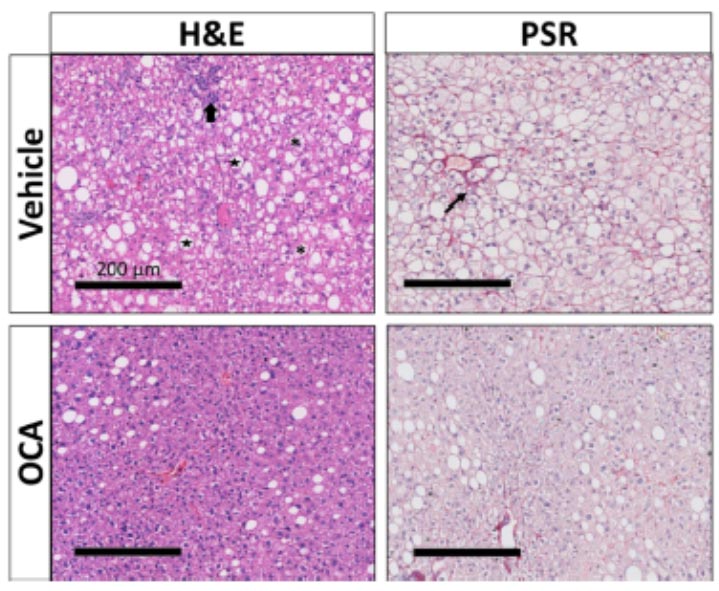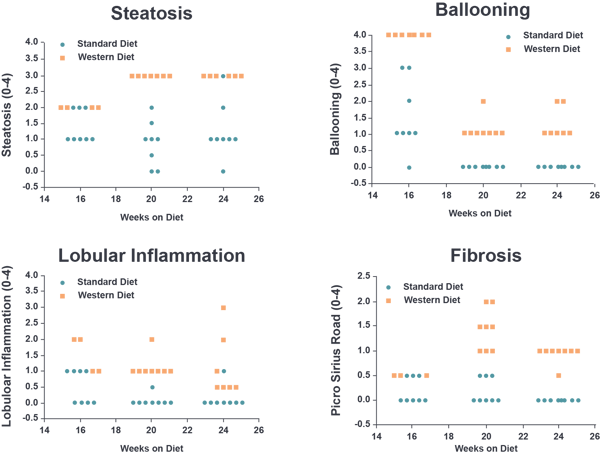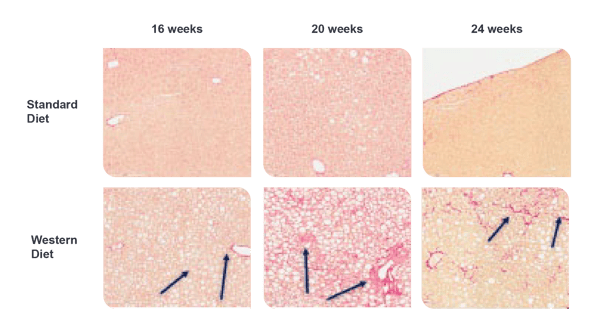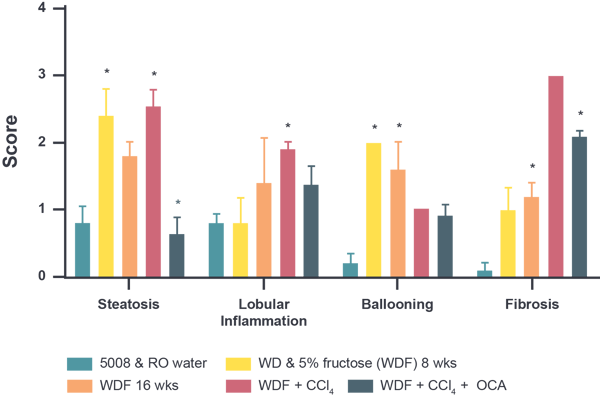
- Services
- Therapeutic Areas
- Model Systems
- In Vitro
- In Vivo
- Technologies
- Service Type
- About Us
- Our Science
- Start Your Study Now

Many existing NAFLD/NASH models display only the histopathology (e.g. fibrosis) or physiological properties of human NAFLD/NASH, therefore lacking clinical relevance. The MS-NASH (formely called FATZO) mouse represents a more translational model, better recapitulating the complex human disease. MS- NASH Key features:
The MS-NASH (formerly called FATZO) mouse model was created by inducing NAFLD/NASH through administration of a “Western diet” plus fructose. On diet, the model develops steatosis, hepatocyte ballooning, inflammation, and fibrosis over time. Progression and exacerbated NASH pathology is accelerated with administration of CCl4.
Western Diet: 21% fat, 0.2% cholesterol, 5% fructose in drinking water.
The MS-NASH mouse is an inbred polygenic animal model for obesity, metabolic syndrome, and diabetes. The model was created through crossing AKR/J and C57BL/6J strains followed by selective inbreeding. Both strains are highly sensitive to developing obesity and metabolic syndrome under the influence of high fat diets, and leptin resistance while gaining adiposity.
The crossing of these two strains and the selective inbreeding of the subsequent generations resulted in the MS-NASH strain, exhibiting obesity in a pre-diabetic state which slowly progresses to overt diabetes.
| Western Diet | Western Diet + CCl4 | |
|---|---|---|
| Steatosis | 4-8 weeks | 4 weeks |
| Ballooning | 16 weeks | 4-8 weeks |
| Inflammation | 16 weeks | 8-16 weeks |
| NASH/Fibrosis | 16-20 weeks | 12-16 weeks |
Table 1: Summary of NAFLD/NASH progression in MS-NASH Mouse on Western diet and accelerated Western diet + CCl4
MS-NASH Model Develops NAFLD Progressing into NASH
by 20 Weeks on a Western Diet

Figure 1: Scoring for progression of NAFLD/NASH pathologies in individual mice. Each dot represents an individual mouse in a cohort, either on a standard diet (blue) or on western diet (orange).
Development of Fibrosis by 20 weeks in MS-NASH Model (Picosirius Red Staining)

Figure 2: Progression of fibrosis in MS-NASH model (Picosirius red staining). Arrows mark fibrotic processes.
MS-NASH Model Shows Improved NAS Score with OCA Treatment
|
Figure 3: OCA treatment improves hepatic ballooning in MS-NASH mice. Representative images of H&E and PSR staining of livers from MS-NASH mice treated with OCA or vehicle |
Figure 4: Histological improvement of WDF fed MS-NASH mice treated with OCA (A) hepatic ballooning, (B) steatosis, (C) lobular inflammation, (D) fibrosis, and (E) NAS score |
CCl4 Induction MS-NASH Liver Histology Scoring

Figure 5: Liver NAS and fibrosis scoring of MS-NASH mice under different diets and treatments, including
CCl4 (purple) and CCl4 + OCA (light blue). OCA reduced steatosis and fibrosis in MS-NASH mice.
© 2024 Crown Bioscience. All Rights Reserved.


© 2024 Crown Bioscience. All Rights Reserved. Privacy Policy
2023-10-09
2021-10-22
site_page